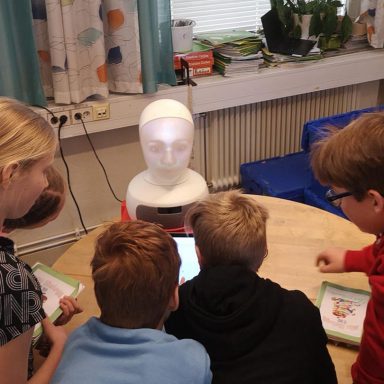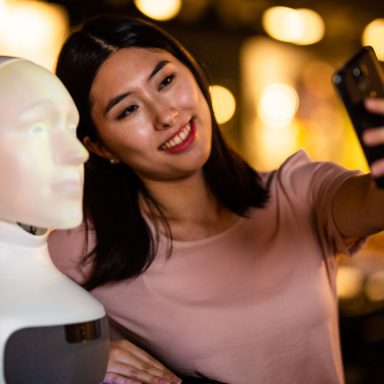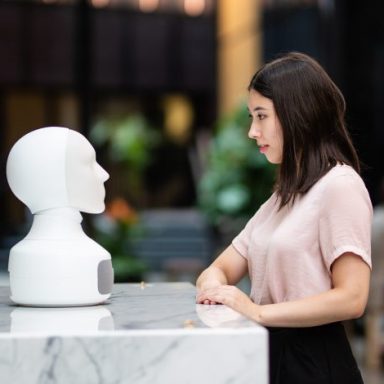In a previous blog, we talked about how social robots can innovate the education and learning industry. But the topic of learning, and training, is much broader than what takes place in schools and universities. It can also apply to a wide range of corporate training and up-skilling. According to research from Statista, the global workplace training industry reached a market size of ~370 billion USD in 2019, with instructor-led classes and online courses being the most common methods to teach skills.
The dependency on human instructors are both costly and time constraining, not to mention the restrictions under Covid-19.
However, we have all felt the fatigue of spending endless hours in online courses where the main takeaway is how to press “next” as fast as possible… there are companies out there that are exploring new solutions, both through the use of chatbots in training and by personalizing the learning path. However, these ideas still mean that we are restricted to a computer which does not make sense for e.g. retail store employees. Could social robots be a solution to make certain types of corporate training both more efficient and similar to the real world?
Social simulation as a tool for training
Let us introduce a term that we at Furhat Robotics are very interested in: social simulation. By this we mean simulations of real-world, social situations and scenarios that could occur during your day at work, such as meeting an upset customer or leading a difficult client meeting. We believe that social simulation is a fantastic way to prepare and practice for challenging work situations, and that social robots are your companion to train with! But wouldn’t it be better to practice with a human colleague or actor, I hear you think? Well, not necessarily!
For training scenarios such as the above, we have outlined five key benefits of using social robots for employee training:
1. Constant availability
A social robot is available around the clock, whenever you might need it. This is specifically important when practicing for social situations, as you likely want to practice an interaction right before entering a specific situation like a sales pitch or meeting customers in a store or meeting. By practicing with a robot instead of a human, you can be flexible and stay on top of your skills when needed.
2. Training at your own speed
A social robot training partner allows you to indulge new knowledge and skills at your own pace – regardless if that is faster or slower than the average group. This also allows training to be divided into different smaller sessions, such as mentioned above, and can target all employees instead of only e.g. new hires or participants at a certain course. Being able to practice a skill when you need it, as opposed to when it fits the schedule, allows for higher buy-in and utilization of the training.
3. Cost efficiency
An always available robot trainer that can practice different scenarios with employees will for logical reasons be more cost-efficient than its human counterpart, specifically in higher volumes. However, this of course assumes that the robot can provide high-quality training equivalent to a human trainer. In reality, a mix of the two might be the way to go, where the robot is the long-term training partner and a human facilitator gives an introductory session.
4. No judgement
An additional value of the idea of a robot trainer is that you do not have to feel the pressure of judgement – you can make as many mistakes as you need, and make countless re-runs and repeats without the risk of annoying anyone or disturbing the overall progress of a group. A related example of this is our partner Tengai, who is working on removing human bias and judgement from initial screening interviews. 75% of job seekers who have met their robot claim that they can be more honest during the robot interview.
5. Data for statistics and analysis
Furthermore, if agreed with the user, data and recordings from the practice sessions can be stored and analyzed to both see the collective improvements of a company or team, but also to be used as input for discussions and feedback sessions together with a manager. We do not believe that the robot should assess, let alone “grade”, an employee – but practicing in a simulated setting can be a fantastic tool to discover strengths and areas for improvements, that one can plan for together with a human colleague or manager.
 Credit: Aagjestudio
Credit: Aagjestudio
Social simulation brought to life in the banking industry
One good example of social simulation in practice is the Dutch multinational bank Rabobank, who back in 2018 wanted to explore ways of improving their corporate learning with focus on bank office employees. Their ambition was to bring learning to the employees in their everyday work, on the job, instead of bringing the employees to a centralized training center for structured courses.
The concept, which is still under consideration for future deployment, simulates a conversation with a bank employee that has to deliver negative information to the customer (i.e. the robot). By practicing such a conversation with the robot, the employees can rehearse their communication strategy and different responses before going out in the real world.
There is of course more to corporate and workplace training than only social simulation – and in these situations, a different tool compared to social robots might be better. 2020 has however taught us both the opportunities and promises of virtual sessions, and we believe that in order to prepare yourself or your staff for physical, real-world circumstances you also need to train in the physical world. And that’s where a social robot can be of real value to you and your company!
—
Are you curious to meet your first Furhat robot? We wish we could meet you physically, but in the meantime make sure to claim a spot on our upcoming webinar to see Furhat in action and grab the opportunity to ask our team any questions.
Meet us online
Our online sessions offer something for everyone. Dive in and learn more about the Furhat platform.




